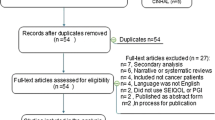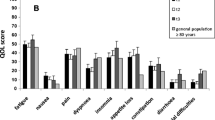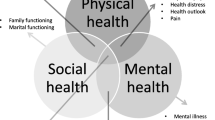Abstract
Purpose
Quality of life (QoL) is one of the most important outcomes in cancer care. Although a number of instruments to measure health-related QoL (HRQoL) exist, there are few suitable instruments to measure individual QoL. The best established instrument is the Schedule for the Evaluation of Individual Quality of Life (SEIQoL). The disadvantage of this questionnaire is its use of semi-structured interviews, which are very time-consuming. The purpose of our study was to transform the SEIQoL into an economical instrument that can be used in clinical trials with large samples.
Methods
We developed the SEIQoL-Questionnaire (SEIQoL-Q) on the basis of the SEIQoL-Direct Weighting (SEIQoL-DW) by transforming the interview guide into a written questionnaire. Patients (N = 1,108) in all three phases of radiation treatment (first consultation, ongoing irradiation, and aftercare) were asked to complete the SEIQoL-Q and the European Organization for Research and Treatment of Cancer QLQ-C30.
Results
While the average HRQoL measured by the QLQ-C30 was 55.6, the average SEIQoL-Q index was 59.6. The most important life domain was “physical health,” followed by “emotional well-being” and “family.” Patients attributed the highest level of satisfaction to “home/housing,” followed by “family” and “partnership.” Male patients were shown to have a significantly better QoL than females. The SEIQoL-Q index correlates moderately with the QLQ-C30 functioning scale “global quality of life” [r = .42 (p < .001)].
Conclusions
According to our findings, the SEIQoL-Q appears to be a feasible and economical instrument for use in quantitative research among cancer patients in different stages of their disease.
Similar content being viewed by others
References
Cleeland, C. S., Sloan, J. A., Cella, D., Chen, C., Dueck, A. C., Janjan, N. A., et al. (2013). Recommendations for including multiple symptoms as endpoints in cancer clinical trials. Cancer. doi:10.1002/cncr.27744.
Becker, G., Hatami, I., Xander, C., Dworschak-Flach, B., Olschewski, M., Momm, F., et al. (2011). Palliative cancer care: an epidemiologic study. Journal of Clinical Oncology. doi:10.1200/JCO.2010.29.2599.
Lowery, A. E., Greenberg, M. A., Foster, S. L., Clark, K., Casden, D. R., Loscalzo, M., et al. (2012). Validation of a needs-based biopsychosocial distress instrument for cancer patients. Psycho-Oncology. doi:10.1002/pon.2008.
Sloan, J. A., Frost, M. H., Berzon, R., Dueck, A., Guyatt, G., Moinpour, C., et al. (2006). The clinical significance of quality of life assessments in oncology: A summary for clinicians. Supportive Care in Cancer. doi:10.1007/s00520-006-0085-y.
Borasio, G. D. (2012). Was ist Lebensqualität in der Palliativmedizin? Arzneimittelforschung. doi:10.1055/s-0031-1300567.
Aaronson, N. K., Ahmedzai, S., Bergman, B., Bullinger, M., Cull, A., Duez, N. J., et al. (1993). The European organization for research and treatment of cancer QLQ-C30: A quality-of-life instrument for use in international clinical trials in oncology. Journal of the National Cancer Institute. doi:10.1093/jnci/85.5.365.
Butt, Z., Lai, J., Rao, D., Heinemann, A. W., Bill, A., & Cella, D. (2013). Measurement of fatigue in cancer, stroke, and HIV using the Functional Assessment of Chronic Illness Therapy—Fatigue (FACIT-F) scale. Journal of Psychosomatic Research. doi:10.1016/j.jpsychores.2012.10.011.
Mystakidou, K., Tsilika, E., Parpa, E., Pathiaki, M., Galanos, A., & Vlahos, L. (2008). The relationship between quality of life and levels of hopelessness and depression in palliative care. Depression and Anxiety. doi:10.1002/da.20319.
Meffert, C., & Becker, G. (2013). Quality of life in terminally ill patients—A challenge for future research. Public Health Forum. doi:10.1016/j.phf.2013.06.008.
Wettergren, L., Kettis-Lindblad, Å., Sprangers, M., & Ring, L. (2009). The use, feasibility and psychometric properties of an individualised quality-of-life instrument: a systematic review of the SEIQoL-DW. Quality of Life Research. doi:10.1007/s11136-009-9490-2.
Joyce, C. R. B., Hickey, A., McGee, H. M., & O’Boyle, C. A. (2003). A theory-based method for the evaluation of individual quality of life: The SEIQoL. Quality of Life Research. doi:10.1023/A:1023273117040.
O’Boyle, C. A., Browne, J., Hickey, A., McGee, H. M., & Joyce, C. R. B. (1993). Schedule for the Evaluation of Individual Quality of Life (SEIQoL): A Direct Weighting procedure for Quality of Life Domains (SEIQoL-DW). Administration Manual. Dublin: Department of Psychology Royal College of Surgeons in Ireland.
Westerman, M., Hak, T., The, A.-M., Groen, H., & Wal, G. van der. (2006). Problems eliciting cues in SEIQoL-DW: Quality of life areas in small-cell lung cancer patients. Quality of Life Research. doi:10.1007/s11136-005-2831-x.
Waldron, D., O’Boyle, C. A., Kearney, M., Moriarty, M., & Carney, D. (1999). Quality-of-life measurement in advanced cancer: Assessing the individual. Journal of Clinical Oncology, 17(11), 3603–3611.
Ring, L., Lindblad, Å. K., Bendtsen, P., Viklund, E., Jansson, R., & Glimelius, B. (2006). Feasibility and validity of a computer administered version of SEIQoL-DW. Quality of Life Research. doi:10.1007/s11136-006-0052-6.
Fegg, M. J., Wasner, M., Neudert, C., & Borasio. G. D. (2005). Personal values and individual quality of life in palliative care patients. Journal of Pain and Symptom Management. doi:10.1016/j.jpainsymman.2005.02.012.
Wedding, U., Pientka, L., & Höffken, K. (2007). Quality-of-life in elderly patients with cancer: A short review. European Journal of Cancer. doi:10.1016/j.ejca.2007.06.001.
Taminiau-Bloem, E. F., Visser, M. R. M., Tishelman, C., Koeneman, M. A., van Zuuren, F. J., & Sprangers, M. A. G. (2010). Somatically ill persons’ self-nominated quality of life domains: Review of the literature and guidelines for future studies. Quality of Life Research. doi:10.1007/s11136-009-9569-9.
Stone, P. C., Murphy, R. F., Matar, H. E., & Almerie, M. Q. (2008). Measuring the individual quality of life of patients with prostate cancer. Prostate Cancer & Prostatic Diseases. doi:10.1038/pcan.2008.16.
Pollack, D., & Müller, O. (2013). Religionsmonitor. Verstehen was verbindet. Religiosität und Zusammenhalt in Deutschland. Gütersloh: Bertelsmann Stiftung.
Hahn, D., & Maschewsky-Schneider, U. (2003). Geschlechtsspezifisches Gesundheitsverständnis. Public Health Forum, 38, 10–11.
Zimmermann, C., Burman, D., Swami, N., Krzyzanowska, M., Leighl, N., Moore, M., et al. (2011). Determinants of quality of life in patients with advanced cancer. Supportive Care in Cancer. doi:10.1007/s00520-010-0866-1.
Kirkova, J., Rybicki, L., Walsh, D., & Aktas, A. (2012). Symptom prevalence in advanced cancer age, gender, and performance status interactions. American Journal of Hospice and Palliative Medicine. doi:10.1177/1049909111410965.
Carlson, L. E., Bultz, B. D., & Morris, D. G. (2005). Individualized quality of life, standardized quality of life, and distress in patients undergoing a phase I trial of the novel therapeutic Reolysin (reovirus). Health and Quality of Life Outcomes. doi:10.1186/1477-7525-3-7.
Frick, E., Borasio, G. D., Zehentner, H., Fischer, N., & Bumeder, I. (2004). Individual quality of life of patients undergoing autologous peripheral blood stem cell transplantation. Psycho-Oncology. doi:10.1002/pon.730.
Conflict of interest
None.
Author information
Authors and Affiliations
Corresponding author
Additional information
Gerhild Becker and Constanze S. Merk have contributed equally to this work.
Rights and permissions
About this article
Cite this article
Becker, G., Merk, C.S., Meffert, C. et al. Measuring individual quality of life in patients receiving radiation therapy: the SEIQoL-Questionnaire. Qual Life Res 23, 2025–2030 (2014). https://doi.org/10.1007/s11136-014-0661-4
Accepted:
Published:
Issue Date:
DOI: https://doi.org/10.1007/s11136-014-0661-4




